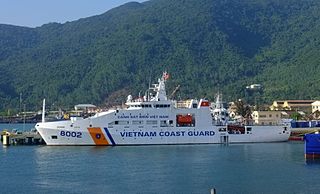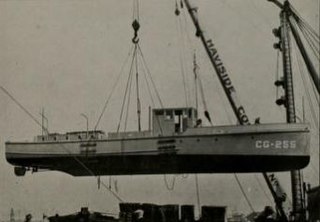Related Research Articles
The Defoe Shipbuilding Company was a small ship builder established in 1905 in Bay City, Michigan, United States. It ceased to operate in 1976 after failing to renew its contracts with the United States Navy. The site of the former company is now being developed for business and housing on the bank of the Saginaw River.

The Damen Group is a Dutch defence, shipbuilding, and engineering conglomerate company based in Gorinchem, South Holland, the Netherlands.

Burrard Dry Dock Ltd. was a Canadian shipbuilding company headquartered in North Vancouver, British Columbia. Together with the neighbouring North Van Ship Repair yard and the Yarrows Ltd. yard in Esquimalt, which were eventually absorbed, Burrard built over 450 ships, including many warships built and refitted for the Royal Navy and Royal Canadian Navy in the First and Second World Wars.
John H. Mathis & Company was a shipbuilding company founded around 1900, based at Cooper Point in Camden, New Jersey, U.S, on the Delaware River. At their shipyard at Point and Erie Streets, the company built luxury yachts and also commercial ships. During World War II a variety of Naval vessels were built. The Mathis shipyard closed in 1961.

YP-26 was a former U.S. Coast Guard wooden patrol boat which saw later duty with the U.S. Navy until destroyed in a 1942 accident.
West Niger was a steam cargo ship built in 1919–1920 by Southwestern Shipbuilding Company of San Pedro for the United States Shipping Board (USSB) as part of the wartime shipbuilding program of the Emergency Fleet Corporation (EFC) to restore the nation's Merchant Marine. The freighter spent her entire career in the Pacific connecting the West Coast of the United States with the Chinese and Japanese ports in the Far East. Early in 1928 the ship together with ten other vessels was sold by the Shipping Board to the States Steamship Co. and subsequently renamed Nevada. In September 1932 the vessel while on her regular trip to Japan ran aground in foggy weather on Amatignak Island and subsequently broke into three parts and sank with the loss of thirty four out of thirty seven men.

The United States Coast Guard wooden-hulled 75-foot patrol boats were built during Prohibition to help interdict alcohol smugglers. Their nickname was derived from the slang term "six bits" meaning 75 U.S. cents.

USS YP-16 was a wooden-hulled patrol vessel in commission in the fleet of the United States Coast Guard as CG-267 from 1925 to 1934, and in the fleet of the United States Navy as YP-16 from 1934 until 1941. She was sunk by Japanese aircraft during the Japanese attack on Guam.

USS YP-17 was a wooden-hulled patrol vessel in commission in the fleet of the United States Coast Guard as CG-275 from 1925 to 1933, and in the fleet of the United States Navy as YP-17 from 1933 until 1941. She was captured by Japanese forces during the Japanese attack on Guam.

USS YP-18 was a wooden-hulled patrol vessel in commission in the fleet of the United States Coast Guard as CG-263 from 1925 to 1934, and in the fleet of the United States Navy as YP-18 from 1934 until 1938.

USS YP-10 was a wooden-hulled patrol vessel in commission in the fleet of the United States Coast Guard as CG-194 from 1925 to 1934, and in the fleet of the United States Navy as YP-10 from 1934 until 1941.

USS YP-15 was a wooden-hulled patrol vessel in commission in the fleet of the United States Coast Guard as CG-149 from 1925 to 1933, and in the fleet of the United States Navy as YP-15 from 1933 until 1945.

USS YP-45 was a wooden-hulled patrol vessel in commission in the fleet of the United States Coast Guard as CG-133 from 1925 to 1934, and in the fleet of the United States Navy as YP-45 from 1934 until 1945.

Splinter fleet or Splinter navy was a nickname given to the wooden boats used in World War II. The boats served in many different roles during the war. These boats were built in small boatyards on the West coast and East coast, Great Lakes and the Gulf of Mexico. They could be built quickly, in just 60 to 120 days. Most of the boats were built by boatyards that already had the tools and knowledge from building yachts, sailboats and motor boats. Many were built by craftsmen in family-owned small businesses. Under the Emergency Shipbuilding Program and War Shipping Administration contracts went out to over fifty boatyards across the country. The boats were built for the US Navy, the, United States Army Air Forces, United States Coast Guard, and US Army. Some of the wooden boats went to Allied nations on the Lend-Lease program.
CG-113 was a wooden-hulled patrol vessel in commission in the fleet of the United States Coast Guard.
Yuba was a wooden-hulled, stern-wheel steamship that served as a snagboat for the United States Army Corps of Engineers.

USS YP-51 was a wooden-hulled patrol vessel in commission in the fleet of the United States Coast Guard as CG-261 from 1925 to 1934, and in the fleet of the United States Navy as YP-51 from 1934 until 1945.

CG-74339 was a wooden-hulled patrol vessel in commission in the fleet of the United States Coast Guard.
Seizer was a wooden-hulled, stern-wheel steamship that served as the first snagboat for the United States Army Corps of Engineers on the Sacramento River.
References
- 1 2 3 "A. W. de Young Boat & Shipbuilding Company". Pacific Marine Review . Vol. 21. 1924. pp. 245, 392, 490, 538–540, 602.
- 1 2 "Building and Hoisting Rum Chasers". Pacific Marine Review . Vol. 22. January 1925. p. 41.
- ↑ Marine Review, 1924, vol. 21, p. 392
- ↑ Flynn, Jr., James T. (June 23, 2014). Vessels of less than 100-feet in Length (PDF). U.S. Coast Guard Small Cutters and Patrol Boats 1915 - 2012.
- ↑ Pacific Marine Review, 1924, vol 21, p. 538
- ↑ "De Young's Yards Will Smooth Ways of Navigation". Oakland Tribune . February 8, 1925.
- ↑ "Outboard profile and deck plan of shallow draft motorship South Shore II". Pacific Marine Review . Vol. 22. May 1925. p. 227.